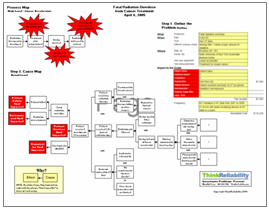Last week’s blog was about a fatal radiation error that killed a patient. After this radiation overdose, New York State health officials issued a warning to healthcare facilities to be careful with linear accelerators used to deliver radiation therapy. However, on the day of this warning, another patient at a different facility in New York was beginning radiation treatment that would eventually cost her life.
The circumstances of this case are very similar to those of the previous radiation therapy overdose. The patient, Alexandra Jn-Charles, was receiving radiation therapy as a follow-up to surgery for an aggressive form of breast cancer. Instead of using the type of linear accelerator with a beam frequency modulator discussed in the last case, the radiation therapy used on Ms. Jn-Charles was from a linear accelerator that was modulated with a metallic block known as a wedge. However, for her radiation therapy, the wedge was mistakenly left out of the machine, resulting in 3.5 times the desired amount of radiation reaching the patient. The error was not noticed throughout her 27 days of radiation treatment.
 As we did with the last case, we can look at this issue in Cause Mapping form. First we can record the basic information of the issue in the problem outline. We capture the what, when, and where in the top part of the outline, then capture the impact to the goals. Here, the patient was killed, which is an impact to the patient safety goal. The error resulted in a fine from the city, which is an impact to the organizational goal. The patient received an overdose on 27 occasions, which is an impact to the patient services goal. Additionally, there was a radiation overexposure, which we will consider an impact to the environmental goal.
As we did with the last case, we can look at this issue in Cause Mapping form. First we can record the basic information of the issue in the problem outline. We capture the what, when, and where in the top part of the outline, then capture the impact to the goals. Here, the patient was killed, which is an impact to the patient safety goal. The error resulted in a fine from the city, which is an impact to the organizational goal. The patient received an overdose on 27 occasions, which is an impact to the patient services goal. Additionally, there was a radiation overexposure, which we will consider an impact to the environmental goal.
We begin our Cause Map with these impacts to the goals. The patient received an overdose of radiation therapy because the patient was receiving radiation therapy to treat her aggressive breast cancer. (This treatment was following surgery and chemotherapy.) The overdose occurred when the radiation was ineffectively filtered. The wedge that filters radiation from the linear accelerator was left out of the machine. The machine was programmed for ‘wedge out’ instead of ‘wedge in’ and the error was not noticed by either other therapists or physicists who did a weekly check of the machine.
The error was not noticed for 27 days. Obviously the safeguards were inadequate, because they allowed a patient to be over-irradiated on 27 occasions. However, it’s unclear whether there were no required over-checks which would have caught the error or whether these over-checks were not performed.
Because we are still lacking somewhat in information on what exactly occurred and what procedures exist, we would need to ask some more questions to complete this Cause Map before we are able to find effective solutions. However, I’m sure that the healthcare facility involved, as well as New York State, is doing this right now and ensuring that this sort of error will never happen again.
To view the beginnings of this root cause analysis investigation, click on “Download PDF” above.
